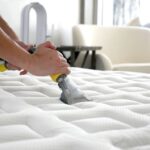Carpets: those plush havens for bare feet and cozy evenings. But like all good things, they require care to maintain their beauty and functionality. Here’s where understanding carpet fibers becomes a game-changer. By identifying the type of fiber gracing your floor, you unlock the key to effective, safe cleaning, extending your carpet’s lifespan and keeping it looking fresh.
The Science of Carpet Fibers: A Breakdown of Common Types
Carpets come in a vibrant tapestry of materials, each boasting unique characteristics. Here’s a breakdown of the most common carpet fiber types:
- Nylon: The reigning champion of durability, nylon is a synthetic fiber renowned for its resilience against wear and tear. It’s stain-resistant and bounces back from heavy traffic, making it ideal for high-traffic areas. Think living rooms, hallways, and even playrooms.
- Polyester: Soft and budget-friendly, polyester carpets offer a delightful range of colors. While stain resistance is decent, durability might be a concern in high-traffic zones. Consider using polyester carpets in bedrooms or guest rooms.
- Olefin (Polypropylene): This budget-conscious option boasts excellent stain resistance and holds its color well. However, olefin fibers tend to crush and may not be as comfortable underfoot. These carpets are suitable for low-traffic areas like basements or utility rooms.
- Wool: Luxurious and naturally stain-resistant, wool offers unparalleled comfort. However, its delicate nature requires gentle cleaning methods and professional attention for deep cleaning. Wool shines in formal living areas or bedrooms.
- Blends: Many carpets combine different fibers to create a balance of properties. Identifying the dominant fiber and any special care requirements becomes crucial for these blends.
Understanding Your Carpet: Unveiling the Mystery
Now that you’re familiar with the common players, how do you identify the fiber type in your own carpet? Here are a few detective tips:
- Check the label: Most carpets have a label with information about the fiber content. Look for terms like “100% Nylon” or “Wool Blend.”
- The burn test (with caution!): This method involves carefully burning a small, hidden fiber sample (not recommended for synthetic fibers that melt!). Consult a professional for proper identification if needed.
- Visual and textural clues: Nylon tends to be springy and resilient. Polyester offers a soft, almost silky feel. Wool has a luxurious texture and a natural luster. Researching online resources with images and descriptions of different fibers can also be helpful.
Choosing the Right Cleaning Method: A Match Made in Carpet Heaven
Once you’ve identified your carpet’s fiber type, you can confidently choose the most effective and safe cleaning method. Here’s a general guide:
- Regular Vacuuming: The cornerstone of carpet care, regular vacuuming removes loose dirt, dust, and allergens before they get a chance to settle in.
- Spot Cleaning: Accidents happen! Act fast by blotting spills with a clean, absorbent cloth. Avoid harsh chemicals and excessive scrubbing, which can damage the fibers.
- Deep Cleaning: For deep-seated dirt and a thorough refresh, different methods come into play depending on the fiber type:
- Hot Water Extraction (Steam Cleaning): Ideal for deep cleaning of synthetic fibers like nylon and olefin, this method uses hot water and a cleaning solution to loosen and remove dirt. However, it might not be suitable for wool or delicate blends.
- Dry Cleaning: This method utilizes absorbent powders to lift dirt from the carpet surface. It’s a good option for delicate fibers like wool or for areas where moisture might be a concern.
- Bonnet Cleaning: This method employs a rotary machine with a cleaning pad to encapsulate dirt for easier removal. It’s a quick and efficient option for routine maintenance, particularly in commercial settings.
Beyond the Basics: Pro Tips for Carpet Care Champions
- Always refer to the manufacturer’s cleaning recommendations. Specific instructions for your carpet might exist, ensuring optimal care.
- Test any cleaning solution in an inconspicuous area before applying it to the entire carpet surface.
- Professional cleaning: For deep cleaning of delicate fibers like wool or heavily soiled carpets, consider professional carpet cleaning services.
- Preventative measures: Place mats at entryways to trap dirt and debris before they reach the carpet. Regular vacuuming and prompt spill treatment go a long way in maintaining your carpet’s beauty.
Cleaning with Confidence: The Power of Knowledge
By understanding the science behind carpet fibers and choosing the right cleaning methods, you can transform carpet care from a chore into a confidence-boosting act of homeownership. With a little knowledge and the right approach, your carpets will continue to provide comfort, warmth, and beauty for years to come.













